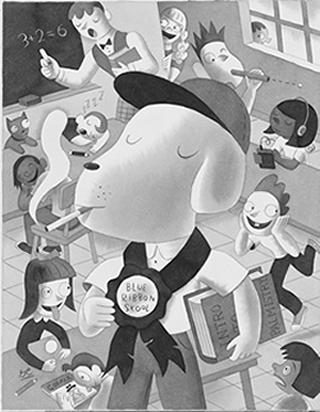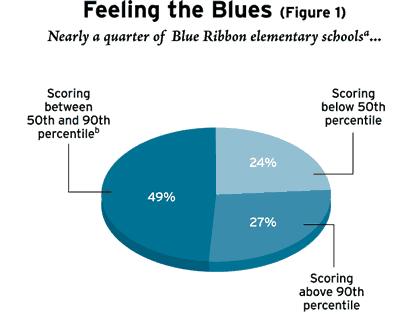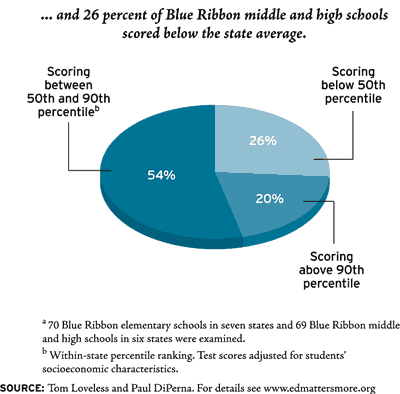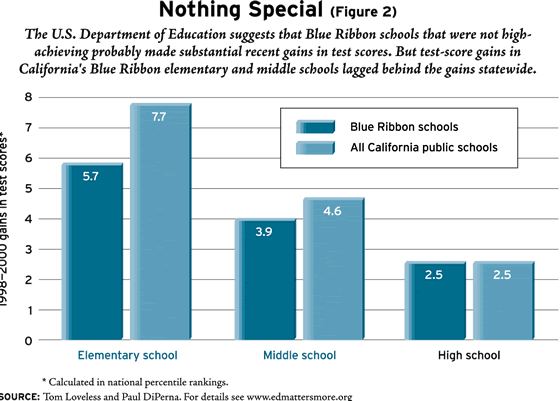
Since 1982 the federal government has recognized more than 4,000 exemplary schools through its Blue Ribbon Schools Program. From the program’s inception, Department of Education officials declared that it would not merely single out the highest-achieving schools, but would also recognize other forms of excellence. Putting aside this expansive view of excellence, how do Blue-Ribbon winners perform on tests of reading and math achievement? Perhaps they are not the highest-scoring schools in each state, but surely they must be near the top or at least score above average.
In a study first reported in the Brookings Institution’s Brown Center Report on American Education in September 2000, we compared the test scores of Blue Ribbon schools with those of an average school in several states. To simplify matters, we confined our analysis to achievement in reading and mathematics. The results were eye opening. We found that approximately a quarter of Blue Ribbon winners are indeed high achieving, scoring among the top 10 percent of schools after adjusting the scores for students’ socioeconomic status. However, an equal percentage of Blue Ribbon schools scored below average after making the adjustment for students’ socioeconomic status. The remaining schools, about 50 percent of Blue Ribbon winners, scored above average, but not extraordinarily so-above their state’s mean, but well short of the 90th percentile.
Here we update our findings by including the year 2000 Blue Ribbon award winners and examining the academic growth of Blue Ribbon schools in California from 1998 to 2000. This analysis reaffirms the previous study’s key finding-that blue ribbons are awarded to many mediocre schools. Which begs a question: Can this be squared with the federal government’s acknowledged goal of holding schools accountable for student learning? Even if one accepts the notion that excellence comes in many forms, imagine two schools in the same neighborhood, one that raises its students to extraordinary heights in reading and mathematics, the other with a lackluster record of academic achievement. What kind of excellence is so important that it compels the federal government to give a Blue Ribbon award-the highest honor that the nation bestows on a school-to the mediocre school while overlooking the exemplary one?
Choosing Blue Ribbon Schools
The Blue Ribbon awards alternate from year to year, going to elementary schools one year, middle and high schools the next. Schools nominate themselves. They first submit an application packet to the education department of their respective states. States screen applicants and forward promising nominees to the U.S. Department of Education. Some states nominate candidates for the national award in conjunction with their own school-recognition program. The Department of Education then convenes a panel of experts, the National Review Panel, to evaluate the quality of the applications. About half of the applicants advance to the site-visit stage. For all but a few schools, receiving a site visit is tantamount to receiving an award. In 1999, 377 schools were nominated by states, 202 schools received site visits, and 198 won awards.
The application packet includes dozens of questions developed by approximately 200 researchers, practitioners, and staff members from state and federal educational agencies, professional associations, and large foundations. Schools are asked to report how often they engage in what the experts on this panel regard as “best practices.” School practices are organized into eight categories: student focus and support; school organ-ization and culture; challenging standards and curriculum; active teaching and learning; professional community; leadership and educational vitality; school, family, and community partnerships; and indicators of success. The last category is the only one that requests data on student achievement.
A Blue Ribbon award is a source of pride for both schools and communities. Educators put loads of effort into preparing the application. A recent Washington Post article described how one school shut down its library for two weeks so that two employees could work 12 hours a day finishing a 71-page application, full of attractive bells and whistles such as charts and graphs. The school principal and a committee of 41 parents and teachers were involved in putting together the submission.
Academic Achievement
We analyzed test data from several states, adjusting for the percentage of students in a school eligible for the federal free and reduced-price lunch program. This removes, albeit imperfectly, the effects of family background on student achievement, so that we can focus solely on what the schools add to student perform-ance. We then examined their income-adjusted scores to discover how many Blue Ribbon schools scored in the top 10 percent of each state’s schools, indicating extraordinarily high achievement, and in the bottom 50 percent of each state’s schools-in other words, below average for similar schools in the state.
In 1999, the most recent year in which elementary schools were selected, the achievement of Blue Ribbon schools was above average, but hardly outstanding. Nineteen of the 70 elementary-school winners scored in the top 10 percent of all schools in their states, but almost as many, 17, scored below average. In 2000, the last year in which middle and high schools were selected, the achievement of Blue Ribbon schools was worse. Only 14 of 69 award winners scored in the top 10 percent; 18 scored in the bottom 50 percent. As a group, the Blue Ribbon schools score above average in reading and math, but not extraordinarily so. About a quarter of the winners actually exhibit lower academic achievement than the average school with a similar demographic profile (see Figure 1).


This pattern directly reflects the priorities of the Blue Ribbon program’s application packet. Academic achievement is one factor in being selected, but not the only factor and certainly not a make-or-break issue in winning the award. Schools that have experience filling out grant applications or other applications similar to those required for the Blue Ribbon award apparently know how to spin mediocre test scores so that they don’t diminish a school’s chances for an award.
Supporting this hypothesis, the low-achieving winners, those that scored in the bottom 50 percent, tend to be located in wealthy neighborhoods. They have about half as many students on free and reduced-price lunches as the average school in their respective states. Take Michigan, for instance. The three elementary schools that fell in the bottom 50 percent are located in the same leafy suburb north of Detroit. Less than 10 percent of the students in these schools receive free or reduced-price lunches. About 75 percent of their students score at the proficient level on Michigan’s test, the MEAP—a respectable number, but hardly impressive given that dozens of Michigan schools with similar demographic characteristics routinely report more than 90 percent of their students achieving at the same level of proficiency. Moreover, there are schools in downtown Detroit with higher test scores than the three Blue Ribbon schools. The share of disadvantaged children at these inner-city schools is several times that of the Blue Ribbon award winners.
After the release of the Brown Center’s report in September 2000, Stephen O’Brien, the Blue Ribbon program’s director, criticized both our reliance on academic achievement as the sole barometer of a good school and our reliance on absolute scores rather than gains in achievement from year to year. He stressed that honored schools may score below average, but they may also have significantly improved their scores over previous years. It’s true that demonstrating academic growth is certainly worthy of national honor. Indeed, if the assumptions of the Blue Ribbon program are correct, using the “best practices” endorsed in the application packet should yield above-average gains. If the winning schools were attaining above-average gains, no one would contest their receiving awards.
To investigate this question, we had hoped to use the same seven states as the original analysis, but most of them had not released year 2000 test data in time for this article. Fortunately, California had released 2000 achievement data on its website. Moreover, the state has a large pool of Blue Ribbon winners and has administered the same standardized test (the SAT 9) over the past three years, allowing for a good estimate of academic growth. We used these data to examine the aca-demic growth of Blue Ribbon schools from 1998 to 2000.
Blue Ribbon schools did make gains during this period, but they barely kept pace with California’s gains overall. In fact, they made less progress than the state’s average school at the elementary- and middle-school levels. From 1998 to 2000, while elementary schools statewide gained 7.7 percentile points, the Blue Ribbons gained only 5.7 points. Middle schools in the state registered a gain of 4.6 points; Blue Ribbons, only 3.9 points. High-school Blue Ribbon winners matched the state’s average 2.5-point gain (see Figure 2).

The mediocre achievement of the Blue Ribbons is apparent in California’s monetary awards program. The state set goals, based on student achievement in 1999, for each school to attain in 2000. Schools meeting these targets received cash bonuses, some as large as $25,000 per teacher. Schools falling short received nothing, but they have another shot at hitting their targets in 2001. The year 2000 achievement data determined the first award winners.
The state’s Blue Ribbon schools failed to earn significantly more cash awards than other schools in the state. Fully 75 percent of the state’s elementary schools received cash awards; 76 percent of the 1999 Blue Ribbon schools did. Among the state’s middle schools, 56 percent reaped awards for meeting their achievement goals, compared with 62 percent of the last two cohorts of Blue Ribbon middle schools (1998 and 2000). At the high-school level, 38 percent of the state’s schools won awards, but only 36 percent of Blue Ribbon high schools did.
This analysis has a serious limitation: California is only one state. Nevertheless, the results are stunning. Schools can win a Blue Ribbon award without demonstrating high levels of reading and math achievement or attaining large gains in these subjects. Which leads to a startling fact: In 2000, nearly two-thirds of Blue Ribbon high schools in California did not receive their own state’s monetary award for high achievement.
Setting the Right Goals
Poor implementation is not the reason why the federal government’s premier school-recognition program fails consistently to select schools with extraordinary achievement; there is no evidence of administrative malfeasance or cronyism. The flaws are structural, built right into the Blue Ribbon program. And they are nonpartisan, existing through Democratic and Republican administrations.
The problems start with the self-selection of nominees. This places low-income schools at a disadvantage. They are less likely than schools in wealthy neighborhoods to have the time and expertise, or to receive the necessary help from volunteers, to complete the application process or to campaign for the award. Indeed, schools with large numbers of disadvantaged students may simply have better things to do than to apply for awards. The Blue Ribbon schools that we identified as low achieving (in the bottom 50 percent) are often quite privileged. Eliminating self-nomination would raise the program’s costs, requiring program officials to find deserving schools on their own, but it would make the program more equitable.
The problems continue with the program’s support for “best practices” that have no basis in research. In the field of education, expert panels have a bad habit of embracing fads. The application for Blue Ribbon schools recommends student-initiated learning, curriculum integration, extracurricular opportunities, elimination of tracking and ability grouping, teaching to different learning styles, and technology integration. There is no convincing body of research showing that these practices are valuable. Extracurricular activities are helpful to a point, but they can undermine achievement if they absorb too much of a student’s time. Studies are inconclusive as to the effect of tracking and ability grouping on achievement. Instruction emphasizing student-initiated learning has a long history of failure, appearing as far back as the 1920s and reemerging in the 1960s in discovery learning and open schools.
Buzzwords are ubiquitous in the Blue Ribbon schools’ mission statements. Schools say they empower parents and teachers or act as catalysts in getting students to aim for a vision. They also offer catchy slogans, proclaiming a “move into the future” and their desire to forge close bonds with the “community.” Schools proudly describe their “site-based management model” or commitment to “student-centered education” and “open-spaced instruction.” These words echo popular platitudes but have little or nothing to do with academic achievement.
Finally, the program’s fundamental flaw is its failure to place a premium on learning. Instead of making high academic achievement the centerpiece of the selection process, the application asks last for evidence of student learning. High achievement in reading and mathematics is surely the defining characteristic of an exemplary school. The Blue Ribbon Schools Program should put it first and make it the most important qualification. The application packet is not shy in imposing other nonnegotiable requirements. A school is ineligible to apply if it is under investigation for violating special-education statutes or has failed to resolve a civil rights complaint. The same exalted status should be accorded academic achievement.
American education has entered a new era of accountability. Increasingly, schools are judged by results. Many analysts now argue that state and federal regulators should leave decisions regarding methodology to the educators within the school walls. Within this reform environment, the Blue Ribbon Schools Program is a dinosaur. It judges schools by what they do instead of what they accomplish. It brings experts together to create a checklist of best practices, asks schools to report which of the practices they use, convenes another panel of experts to judge those responses, and then sends evaluators out to verify the schools’ claims.
The result is a lost opportunity to highlight the best schools in the nation and to learn from their examples. In most walks of life, blue ribbons are given to those who compete and perform at a high level, finishing at the top of their group. In education, that means schools that teach their students more than other schools. They and they alone should receive the federal government’s Blue Ribbon award.
—Tom Loveless directs the Brown Center on Education Policy at the Brookings Institution. Paul DiPerna is a researcher in the Brown Center.


